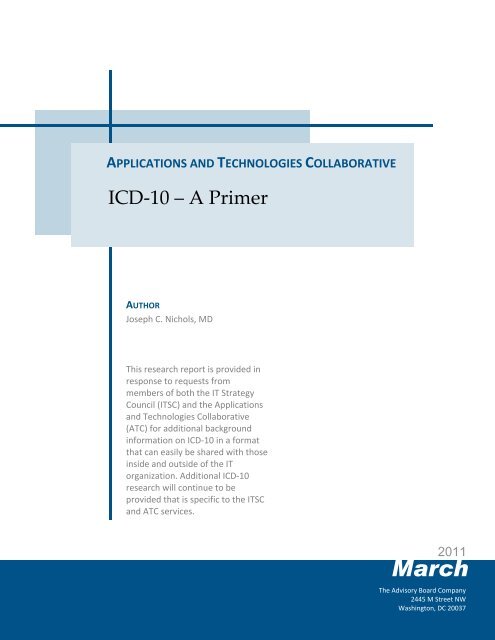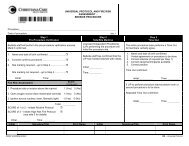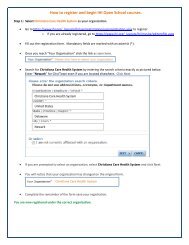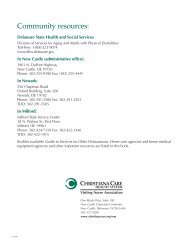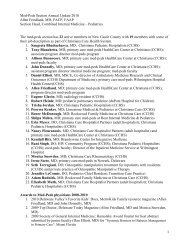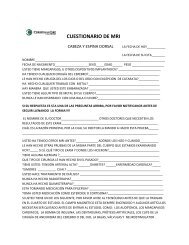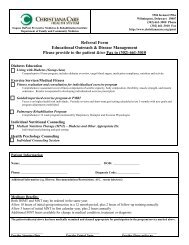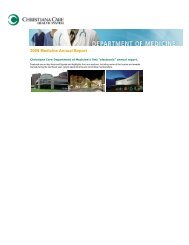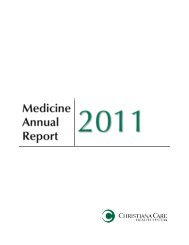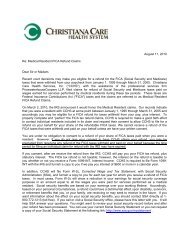ICD-10 Primer - Christiana Care Health System
ICD-10 Primer - Christiana Care Health System
ICD-10 Primer - Christiana Care Health System
Create successful ePaper yourself
Turn your PDF publications into a flip-book with our unique Google optimized e-Paper software.
APPLICATIONS AND TECHNOLOGIES COLLABORATIVE<strong>ICD</strong>-<strong>10</strong> – A <strong>Primer</strong>AUTHORJoseph C. Nichols, MDThis research report is provided inresponse to requests frommembers of both the IT StrategyCouncil (ITSC) and the Applicationsand Technologies Collaborative(ATC) for additional backgroundinformation on <strong>ICD</strong>-<strong>10</strong> in a formatthat can easily be shared with thoseinside and outside of the ITorganization. Additional <strong>ICD</strong>-<strong>10</strong>research will continue to beprovided that is specific to the ITSCand ATC services.2011MarchThe Advisory Board Company2445 M Street NWWashington, DC 20037
Page 2 of 14Table ofContentsTable of Contents .................................................................................................................... 2Overview .................................................................................................................................. 3Regulatory Requirements ........................................................................................... 3Magnitude of the Changes .......................................................................................... 3Cost of Migration .................................................................................................................... 3<strong>ICD</strong>-<strong>10</strong>-CM ............................................................................................................................... 4<strong>ICD</strong>-<strong>10</strong>-PCS .............................................................................................................................. 5Crosswalks .................................................................................................................... 6Equivalent Aggregation (Grouping) ......................................................................... 6Mapping ........................................................................................................................ 7GEM ............................................................................................................................... 7Business Impacts ..................................................................................................................... 8Reporting & Analytics ............................................................................................................ 9Technical Requirements ....................................................................................................... <strong>10</strong>Database Changes ...................................................................................................... <strong>10</strong>Data Definition & Validation .................................................................................... 11Interface ....................................................................................................................... 11Rules ............................................................................................................................. 11Testing ......................................................................................................................... 11Leveraging the Advantages – Better Information ............................................................ 11Greater Detail .............................................................................................................. 12Enhanced Categorization Models ............................................................................ 12Greater Severity and Risk Definition ....................................................................... 12Greater Precision of Definition ................................................................................. 12Greater Forward Flexibility ...................................................................................... 12Greater Ability to Integrate Clinical Information .................................................. 13Acronym Key ........................................................................................................................ 12Leveraging the Advantages – Better Business .................................................................. 13More Appropriate Contracting ................................................................................ 13More Precise Payment ............................................................................................... 13Better Definition of Severity, Risk, and Case Mix .................................................. 13Improved Measurement of Quality, Efficiency, and Outcome Measures .......... 13Enhanced Network Management ............................................................................ 13Better Fraud and Abuse Detection ........................................................................... 13Better Risk Prediction ................................................................................................ 14A Competitive Advantage ........................................................................................ 14Compliance ................................................................................................................. 14Summary ................................................................................................................................ 14ABC Research Report ● The Advisory Board Company2445 M Street, NW ● Washington, DC 20037 ● Telephone: 202-266-5600 ● Facsimile: 202-266-5700 ● www.advisory.com
Page 3 of 14OverviewThe United States currently uses a 30 year old coding system to report patient healthconditions. This coding system is woefully inadequate to accommodate changes inhealth care and the increasing demand for more meaningful information fromstandard health care transactions. In 1990 the World <strong>Health</strong> Organization adopted<strong>ICD</strong>-<strong>10</strong> as the international version of diagnostic codes. These codes are used widelyinternationally as well as for mortality reporting in this country, but have yet to beadopted as the standard for diagnosis related coding in the United States.Regulatory RequirementsIn January of 2009, the final rule 1 was published that required the use of <strong>ICD</strong>-<strong>10</strong>codes on all HIPAA transactions. The regulation requires that claims will not beaccepted with <strong>ICD</strong>-9 codes for outpatient services with dates of service on or afterOct 1, 2013. Similarly inpatient claims are not to be accepted with discharge dates onor after Oct 1, 2013. The new standard for diagnostic coding under this regulation isthe U.S. version of <strong>ICD</strong>-<strong>10</strong>; <strong>ICD</strong>-<strong>10</strong>-CM 2 . The new standard for institutionalprocedure codes is <strong>ICD</strong>-<strong>10</strong>-PCS 3 .Magnitude of the ChangesThis migration from the current <strong>ICD</strong>-9 standard to the <strong>ICD</strong>-<strong>10</strong> standard willrepresent one of the greatest changes in health care information in many years.These codes are used not only for analytic and reporting purposes; they areingrained in most business processes. They factor into pricing, payment, contractingrisk prediction, and a variety of other mission critical business functions. Rules,categorizations, and a variety of edits and algorithms to support many differentbusiness functions use these codes either as table look ups or as hard coded logic inexisting systemsCost of MigrationA number of studies have looked at the cost of this transition for payers, providers,and the industry as a whole. While there is considerable variation in cost estimatesacross these studies, most suggest that the cost will be in the billions and require asignificant refocusing of existing resources 4,5 . Estimates of the systemimplementation cost for a 400+ bed hospital range between $500,000 and $2,000,000per entity 6 . Estimates of the cost of implementation for clinical practices range from$83,000 for a small clinical practice to over $2,700,000 for a large clinical practice 7 .The actual cost of implementation across the industry could be substantially highersince most of these estimates were made before organizations had any significantassessment experience. As organizations have looked deeper into areas of potential1http://edocket.access.gpo.gov/2009/pdf/E9-743.pdf2 The U.S. version (<strong>ICD</strong>-<strong>10</strong>-CM) is substantially different from the international <strong>ICD</strong>-<strong>10</strong> version. The international version has ~12,500codes as compared to the U.S, version which ~69,000 codes.3 <strong>ICD</strong>-<strong>10</strong>-PCS is not related to any international standard and was developed by 3M on behalf of CMS for use in this country as areplacement for the <strong>ICD</strong>-9 volume 3 institutional procedure codes.4 Martin Libicki & Irene Brahmakulam, The Costs and Benefits of Moving to the <strong>ICD</strong>-<strong>10</strong> Code Sets, RAND Corporation, March 20045 Replacing <strong>ICD</strong>-9-CM with <strong>ICD</strong>-<strong>10</strong>-CM and <strong>ICD</strong>-<strong>10</strong>-PCS: Challenges, Estimated Costs and Potential Benefits, Robert E. Nolan Company,October 200 36 Thomas Wildsmith, Examining the cost of implementing <strong>ICD</strong>-<strong>10</strong>, The Hay Group, October 20067 Stanley Nachimson, The impact of implementing <strong>ICD</strong>-<strong>10</strong>, Nachimson Advisors, October 2008.ABC Research Report ● The Advisory Board Company2445 M Street, NW ● Washington, DC 20037 ● Telephone: 202-266-5600 ● Facsimile: 202-266-5700 ● www.advisory.com
Page 4 of 14<strong>ICD</strong>-<strong>10</strong>-CMimpact, many have been surprised by the magnitude of the resources that will berequired to make this transition.<strong>ICD</strong>-<strong>10</strong> is the standard for diagnosis codes managed as an ‘international’ standard bythe World <strong>Health</strong> Organization. This standard is used (with modifications) by mostcountries outside of the United States. <strong>ICD</strong>-<strong>10</strong>-CM is the U.S. version of this codestandard, but differs significantly from the international standard in that it containsover 69,000 codes as compared to the WHO standard which contains ~ 12,500 codes.Australia and Canada also have significant variation from the U.S. Standard withtheir own modifications of the international <strong>ICD</strong>-<strong>10</strong> standard.The nature of the difference between <strong>ICD</strong>-9 (diagnosis codes) and <strong>ICD</strong>-<strong>10</strong>-CM(diagnosis codes) can be illustrated in the example in fig. 1 which shows the bestpotential code in <strong>ICD</strong>-9 and <strong>ICD</strong>-<strong>10</strong> to represent the same key medical concepts in thesame clinical scenario. In this example, the <strong>ICD</strong>-9 code is unable to fully representthe concepts in [red] as compared to the richer medical concept support in <strong>ICD</strong>-<strong>10</strong>.Fig.1Table 1 demonstrates some of the key differences between <strong>ICD</strong>-9 and <strong>ICD</strong>-<strong>10</strong> codestandards.<strong>ICD</strong>-9 CM Diagnosis Codes (Vol. 1 & 2)<strong>ICD</strong>-<strong>10</strong>-CM Diagnosis Codes~14,000 Codes ~ 69,000 CodesUp to 5 characters all numeric (except for the 1 stcharacter for ‚E‛ and ‚V‛ codes)Limited inclusion of co-morbidities,complications, severity, manifestation, risk,sequelae, and other disease related parameters.Does not distinguish laterality (left vs right vsbilateral)Does not define initial and subsequentencountersUp to 7 characters all of whichcould be alpha or numericcharactersIncludes many of theseparameters within codes.Usually includes laterality whereappropriateIncludes these conceptsABC Research Report ● The Advisory Board Company2445 M Street, NW ● Washington, DC 20037 ● Telephone: 202-266-5600 ● Facsimile: 202-266-5700 ● www.advisory.com
Page 5 of 14<strong>ICD</strong>-9 CM Diagnosis Codes (Vol. 1 & 2)Expansion ability is limitedConsistency of terms and definition has been achallengeCombination codes are limited.Table 1<strong>ICD</strong>-<strong>10</strong>-CM Diagnosis CodesAlphanumeric support andplace holders characters providesignificant ability to expand thecodes sets without a significantstructural changeConsistency for terms andconcepts has been improved.Combination codes are frequent,with multiple distinct medicalconcepts per code.<strong>ICD</strong>-<strong>10</strong>-PCSThe <strong>ICD</strong>-<strong>10</strong>-PCS codes are a set of codes that represent procedures that areperformed and reported on institutional (hospital-based) claims and other relatedtransactions. Despite the name, <strong>ICD</strong>-<strong>10</strong>-PCS codes are neither international norassociated with any specific diagnosis codes. These codes are specific to the US andare not part of any international standards. They were developed under a contractbetween CMS and 3M. There first draft was completed in 1993 with an initial releasein 1998 for review. There have been updates annually; however the codes are notbeing used today. Regulatory requirements state that this <strong>ICD</strong>-<strong>10</strong>-PCS will be thestandard code for the definition of institutional procedures 1 for all HIPAAtransactions with dates of discharge on or after Oct 1, 2013. There are dramaticchanges in the structure, terminology, coding rules, and number of codes asillustrated in table 2.<strong>ICD</strong>-9 –CM Procedure Codes (Vol. 3)<strong>ICD</strong>-<strong>10</strong>-PCS Codes~4,000 Codes ~ 72,000 Codes3 to 4 characters all numeric 7 characters all of which couldbe alpha or numeric characters.All 7 characters are requiredNot structuredHighly structuredDiagnosis occasionally includedDiagnosis not includedNEC and NOS (unspecified and elsewhere NEC and NOS are uncommonspecified) are commonEponyms used frequentlyEponyms rarely usedGeneral body locationsDetailed body locationsCombination codes used frequentlyCombination codes are rareCommon medical terminologyCompletely new medicalterminology modelTable 2The nature of the difference between <strong>ICD</strong>-9 (procedure codes) and <strong>ICD</strong>-<strong>10</strong>-PCS(procedure codes) can be illustrated in the example in fig. 2 which shows the bestpotential code in <strong>ICD</strong>-9 and <strong>ICD</strong>-<strong>10</strong>-PCS to represent the same key medical conceptsrelated to a procedure. In this example, the <strong>ICD</strong>-9 code is unable to fully representthe concepts in [red] as compared to the richer medical concept support in <strong>ICD</strong>-<strong>10</strong>.1Professional services and some institutional outpatient services will still be defined based on existing HCPC and CPT codes.ABC Research Report ● The Advisory Board Company2445 M Street, NW ● Washington, DC 20037 ● Telephone: 202-266-5600 ● Facsimile: 202-266-5700 ● www.advisory.com
Page 6 of 14Fig. 2The nature of these codes will require a major translation process to assure that codesin different <strong>ICD</strong> standards can be normalized to support existing processes andanalysis. This translation will take two forms; ‚Crosswalks‛ and ‚EquivalentAggregations‛ (or Grouping) of codes. During the time surrounding the migrationfrom <strong>ICD</strong>-9 to <strong>ICD</strong>-<strong>10</strong>, there will be significant impacts to the quality and reliabilityof information due to the many-to-many relationship of these codes and the factthere are considerable differences in supported granularity. Over 95% of the bestpossible matches between <strong>ICD</strong>-9 and <strong>ICD</strong>-<strong>10</strong> codes will be inexact. This meansthat that some information may be lost in translation, or some information may beassumed when there is no evidence to support the new detail. Clearlyunderstanding the process and limitations of mapping will be critical tounderstanding the nature of health care data during this migration.CrosswalksCrosswalks are specifications that state what code in <strong>ICD</strong>-9 or in <strong>ICD</strong>-<strong>10</strong> should bemigrated to a corresponding code or codes in its corresponding standard.Crosswalks are intended to support automated translation rather than manualcoding where other clinical information is used to code the clinical scenario to theappropriate code.A ‚Crosswalk‛ is the deliverable that answers the question:‚If I need to replace an <strong>ICD</strong>-9 code with one or more <strong>ICD</strong>-<strong>10</strong> code(s), which <strong>ICD</strong>-<strong>10</strong>code(s) would best represent the concepts that the original <strong>ICD</strong>-9 code intended torepresent?‛As noted above, codes that have been cross-walked will be inexact 95% of the timeand result in lost or assumed information in the translation process.Equivalent Aggregation (Grouping)ABC Research Report ● The Advisory Board Company2445 M Street, NW ● Washington, DC 20037 ● Telephone: 202-266-5600 ● Facsimile: 202-266-5700 ● www.advisory.com
Page 7 of 14Equivalent Aggregation is the process for defining the codes in the <strong>ICD</strong>-<strong>10</strong> standardthat represent the original intent of policies, rules reporting categories, algorithms,and other processes where a set of codes has been defined to represent some medicalconcept like ‘Acute Myocardial Infarction’. Because of the change in the codestructures and the fact that current concepts may not be represented or arerepresented differently, a simple crosswalk from a current group of codes to a newgroup of codes in <strong>ICD</strong>-<strong>10</strong> may not capture the intent of the rule, policy, orcategorization.An ‚Equivalent Aggregation‛ is the deliverable that answers the question:‚If I need to replace the original intent of a grouping of <strong>ICD</strong>-9 codes with anequivalent grouping of <strong>ICD</strong>-<strong>10</strong> codes, which <strong>ICD</strong>-<strong>10</strong> codes would best represent theoriginal intent of the group of <strong>ICD</strong>-9 codes?‛Example: A medical policy may define the appropriate use of ‚Chelation Therapy‛as treatment directed at conditions involving ‚heavy metal toxicity‛. This treatmentfor all other conditions is considered inappropriate and would not be paid. Thefollowing represents an analysis of the codes related to this policy:24 <strong>ICD</strong>-9 codes related to ‚heavy metal toxicity‛ were part of the ‚inclusion‛ listfor appropriate diagnosis associated with this treatment under the original policy.42 <strong>ICD</strong>-<strong>10</strong> codes would be mapped to the above note <strong>ICD</strong>-9 codes based on theGEM <strong>ICD</strong>-9 to <strong>ICD</strong>-<strong>10</strong> mapping file.<strong>10</strong>0 <strong>ICD</strong>-<strong>10</strong> codes related to ‚heavy metal toxicity‛ (as determine through directresearch of <strong>ICD</strong>-<strong>10</strong> codes) would be used in a new policy based on the ‘medicalintent’ of the original policy.In this case, new <strong>ICD</strong>-<strong>10</strong>-CM codes representing types of heavy metal toxicity like‚lead induced gout‛ were never included in <strong>ICD</strong>-9. Additionally a standardcrosswalk from <strong>ICD</strong>-9 to <strong>ICD</strong>-<strong>10</strong> might only include a fraction of the appropriatecodes. To properly redefine the policy to be consistent with its ‚medical intent‛ the<strong>ICD</strong>-<strong>10</strong> codes need to be researched independent of how codes were selected in <strong>ICD</strong>-9.MappingMapping is the process of arriving at the deliverables noted above.Creating the ‚crosswalk‛ requires the identification of the code or combination ofcodes that best translates a code from <strong>ICD</strong>-9 to <strong>ICD</strong>-<strong>10</strong> or from <strong>ICD</strong>-<strong>10</strong> to <strong>ICD</strong>-9.Crosswalks are generally bi-directional and may be different for each directionbecause of the mixed granularity of the codes.Creating ‚Equivalent Aggregation‛ requires that the medical intent of the policy isrepresented in <strong>ICD</strong>-<strong>10</strong> codes. This should not be mapped by using a code basedcrosswalk, but rather the new group of codes should be defined based on a clearunderstanding of the medical intent and then reflecting that intent in the newcode set.GEMGeneral Equivalency Mapping (GEM) files have been created by 3M at the request ofCMS to provide some assistance in the mapping process. These files are bi-ABC Research Report ● The Advisory Board Company2445 M Street, NW ● Washington, DC 20037 ● Telephone: 202-266-5600 ● Facsimile: 202-266-5700 ● www.advisory.com
Page 8 of 14directional from <strong>ICD</strong>-9 to <strong>ICD</strong>-<strong>10</strong> and from <strong>ICD</strong>-<strong>10</strong> to <strong>ICD</strong>-9. There are bi-directionalmaps for both the <strong>ICD</strong>-<strong>10</strong>-CM (diagnosis) codes as well as the <strong>ICD</strong>-<strong>10</strong>-PCS(institutional procedure) codes. They provide some assistance in identifying codesthat might be equivalent for a variety of mapping purposes, but they are notcrosswalks and are not intended to be used as crosswalks. While the GEM files arean important tool in the mapping process, they do not provide a complete solution.Though most of the maps appear to be accurate, there are a number of exampleswhere the maps are clinically inaccurate, incomplete, and applied inconsistently forsimilar codes. Clinical judgment must be part of the process of decision makingwhen using GEM or other tools in crosswalking efforts.Business ImpactsThose who have been recently exposed to <strong>ICD</strong>-<strong>10</strong> codes often ask; ‚Why is this bigdeal. Isn’t it just an update to a code set?‛The migration of <strong>ICD</strong>-9 to codes to <strong>ICD</strong>-<strong>10</strong> codes is perhaps one of the largestchanges in health care information in recent memory. Y2K and even HIPAA‚Administrative Simplification‛ did not represent near as large an impact as themigration of <strong>ICD</strong>-9 to <strong>ICD</strong>-<strong>10</strong>. There are three key reasons that this migration is sucha ‚big deal‛.<strong>ICD</strong> codes are a cornerstone of health information:o <strong>ICD</strong>-9 or <strong>10</strong> diagnosis codes define the health state of the patiento <strong>ICD</strong>-9 or <strong>10</strong> procedure codes define the institutional procedures that patientsmay receive to maintain or improve their health stateThe transition from <strong>ICD</strong>-9 to <strong>ICD</strong>-<strong>10</strong> represents a major change in the codingsystem:o 14,300 <strong>ICD</strong>-9 codes to 69,000 <strong>ICD</strong>-<strong>10</strong> codeso 3,800 <strong>ICD</strong>-9 procedure codes to 72,000 <strong>ICD</strong>-<strong>10</strong> procedure codeso Major changes in structure of the codeso Major changes in coding ruleso Major changes in terminology<strong>ICD</strong> codes are used pervasively through most health care systemso Many business functions are impactedo These codes are ingrained in financial rules directly or indirectlyo Many IT systems are impactedo Paper and electronic documents are impactedSome of the key business areas where these codes play a significant role include:Clinical documentation improvementCoding and coder productivity and accuracyCase mix definitionDRG assignmentABC Research Report ● The Advisory Board Company2445 M Street, NW ● Washington, DC 20037 ● Telephone: 202-266-5600 ● Facsimile: 202-266-5700 ● www.advisory.com
Page 9 of 14AuditsClaim denials or adjustmentsPotential preventable readmission and present on admission conditionsMedical policies and clinical guidelinesQuality and efficiency assessmentFraud, waste, and abuse analysisComparative effectiveness researchOutcomes measuresPopulation health analysisClinical HistoryRegulatory ReportingManaging care in an Accountable <strong>Care</strong> environment.Since there is no experience with how these codes will be used and which of thecodes will be used for which conditions and procedures, it will be difficult topredict how services and conditions will be reported and paid. Understanding thenature of these codes and evaluating the potential impacts will be critical to theviability of health care organizations.Reporting &AnalyticsReporting and analysis in health care often relies on the ability to appropriatelycategorize and group diagnostic and institutional procedure codes. Thesecategorizations will be quite different under <strong>ICD</strong>-<strong>10</strong> because of extensive changes indefinitions, details, and structure of the codes.Example: Consider the following scenario based on an analysis of fractures of thedistal radius:Under <strong>ICD</strong>-9, the following codes might be considered in the analysis:o 5 codes for fracture distal or lower end of the radiuso 2 codes for Colles’ fractureo 2 codes for fracture of the lower end of the forearmo 6 codes for unspecified part of the radiuso 4 codes include the concept of ‚open fracture‛Under <strong>ICD</strong>-<strong>10</strong>, the following codes might be considered in the analysis:o 318 codes for fracture distal or lower end of the radius• 120 Open fractures of the distal or lower part of the radius60 Gustilo class I or II60 Gustilo class IIIa, IIIb, or IIIco 48 Codes for Colles’ fractureo 48 Codes for Barton’s fractureABC Research Report ● The Advisory Board Company2445 M Street, NW ● Washington, DC 20037 ● Telephone: 202-266-5600 ● Facsimile: 202-266-5700 ● www.advisory.com
Page <strong>10</strong> of 14o 48 Codes for Smith’s fractureo 48 Codes for Radial Styloid fractureo 48 Codes for Galeazzi’s fractureo 84 fractures of the forearm ( does not specify ‚upper/proximal‛ or‚lower/distal‛)An analysis that is attempting to define concepts consistently under <strong>ICD</strong>-<strong>10</strong> ascompared to similar analysis under <strong>ICD</strong>-9 will require significant research toidentify how to redefine categories of codes based on the new codes and structurewithin the <strong>ICD</strong>-<strong>10</strong> model. There is not ‚auto-magic‛ solution to redefining groupsor categories of codes in <strong>ICD</strong>-<strong>10</strong>. In this example, if you don’t know that Barton,Smith, Colles, Radial Styloid, and Galeazzi are all types of fractures of the distal(lower end) of the radius bone in the forearm, you would not know to group thesefractures in that general classification.TechnicalRequirementsTechnical requirements are often underestimated. There are those less informed whobelieve that if they have a field of the appropriate length to handle the new codes,that they are ready for compliance. The reality is that most of the major changesassociated with this transition are business changes that will require significantsystem changes to support the new business requirements. Many of thoserequirements (e.g. to support Meaningful Use or Accountable <strong>Care</strong>) are yet to bedefined and will represent a significant part of the planning process. The followingrepresents a limited list of some of the technical changes that may be needed tosupport these new business requirements.Database ChangesData element support for 7 charactersSupport of alpha numeric data typesCode type (<strong>ICD</strong>-<strong>10</strong> vs <strong>ICD</strong>-9) definition.Support of both codes types per recordExpansion of number of codes supported consistent with version 50<strong>10</strong> institutionaland professional electronic data interchange transactionsLink between an <strong>ICD</strong>-9 code and the corresponding <strong>ICD</strong>-<strong>10</strong> code in translated dataMetadata around translation to assure translation accountability and useraccessible audit trailAddition of <strong>ICD</strong>-<strong>10</strong> codes with attributes to include:o Valid begin and end date ( from a processing perspective)o Valid begin and end date ( from a reporting perspective)o Create and delete dateso Long and short descriptionso Unique system ID for code recordsAggregation models to define and support various categorization schemes withmetadata attributes about the nature of the aggregation scheme records.ABC Research Report ● The Advisory Board Company2445 M Street, NW ● Washington, DC 20037 ● Telephone: 202-266-5600 ● Facsimile: 202-266-5700 ● www.advisory.com
Page 11 of 14Support for retrieval of the initial unaltered submitted code after translationprocesses are applied for any external reporting or transaction requirementsData Definition and ValidationUpdate to data dictionariesUpdate to validation processes to include validation to <strong>ICD</strong>-9 or <strong>ICD</strong>-<strong>10</strong> based onthe date of service or date of dischargeUpdate to all inbound and outbound transaction processes to support <strong>ICD</strong>-<strong>10</strong>Update to any file format specifications related to <strong>ICD</strong> codesInterfacesUpdate all fields to support <strong>ICD</strong>-<strong>10</strong> to include:CaptionsData type supportField lengthData sourcesRulesRe-point all rules that used tabled codes to the appropriate reference tables basedon dates of service and dates of dischargeRe-code rules that are hard-coded to reflect the intent of the rule in <strong>ICD</strong>-<strong>10</strong>.TestingTest plans, test cases and test data to support business scenario based testing:RulesReporting categorization modelsValidationInterfacesTranslationAudit trailsLeveraging theAdvantages –Better InformationThese systems changes are only examples of the types of changes that may beneeded. Until there is a deep assessment of business requirements, system engineerswill not know what tasks are on their plate. Early definition of these businessrequirements will be critical if needed system changes and testing are to beaccomplished prior to the implementation date.The cost of implementation as noted previously is anticipated to be substantial forany organization. Beyond compliance, the hope is that there will be significantbusiness benefits to make the required investment worth it. These business benefitswill not happened automatically and will require strategic and tactical planning toleverage the opportunities that <strong>ICD</strong>-<strong>10</strong> brings.ABC Research Report ● The Advisory Board Company2445 M Street, NW ● Washington, DC 20037 ● Telephone: 202-266-5600 ● Facsimile: 202-266-5700 ● www.advisory.com
Page 12 of 14ACRONYM KEYDRGDiagnosis Related GroupGEMGeneral EquivalencyMappingHIPAAThe <strong>Health</strong> InsurancePortability andAccountability Act of 1996<strong>ICD</strong>-9International Classificationof Diseases (9 th Edition)<strong>ICD</strong>-<strong>10</strong>International Classificationof Diseases (<strong>10</strong> th Edition)<strong>ICD</strong>-<strong>10</strong>-CMInternational Classificationof Diseases (<strong>10</strong> th Edition)Clinical Modification<strong>ICD</strong>-<strong>10</strong>-PCSInternational Classificationof Diseases (<strong>10</strong> th Edition)Procedural Coding <strong>System</strong><strong>ICD</strong>-<strong>10</strong> brings significant opportunities to provide better information about theconditions for which patients receive care as well as better information about thetypes of procedures that are performed in hospital based institutions.Greater DetailAs demonstrated earlier in this paper, <strong>ICD</strong>-<strong>10</strong> codes provide much greater detail intothe nature of the reported condition.Enhanced Categorization ModelsThe greater granularity of the codes allows for categorization of conditions andinstitutional procedures that identify significant differences to assure thatcomparisons are as normalized as possible.Example: Growth plate fractures categorized as Salter-Harris type I fractures aresignificantly different that Salter-Harris type IV fractures. Today however, <strong>ICD</strong>-9codes cannot distinguish these two classes of growth plate fractures where as thesetypes are different codes under <strong>ICD</strong>-<strong>10</strong>.Greater Severity and Risk DefinitionThe detail within these codes allows for the differentiation of conditions that varysignificantly in risk and severity. Some of the additional attributes of conditions thatare included in many <strong>ICD</strong>-<strong>10</strong> codes include:Co-morbiditiesManifestationsEtiology/causationComplicationsDetailed anatomical locationSequelaeDegree of functional impairmentBiologic and chemical agentsPhase/stageLymph node involvementLateralization and localizationProcedure or implant relatedGreater Precision of DefinitionMost of the <strong>ICD</strong>-<strong>10</strong> codes also provide detail such as localization anatomically at amuch greater detail to provide far greater precision of definition.Greater Forward FlexibilityThe design of these codes allow for much greater flexibility for modification in thefuture with minimal impact on the underlying structure. Supporting this flexibilityincludes:Increased code lengthABC Research Report ● The Advisory Board Company2445 M Street, NW ● Washington, DC 20037 ● Telephone: 202-266-5600 ● Facsimile: 202-266-5700 ● www.advisory.com
Page 13 of 14Use of alpha or numeric values for all charactersPlace holders (‘x’ in CM and ‘z’ in PCS) for the addition of future valuesA better consistency in terms that allows for re-usability and application of termsin varying conditions.Greater Ability to Integrate Clinical InformationLeveraging theAdvantages –Better Business<strong>ICD</strong>-<strong>10</strong> codes provide a definition of health conditions that is more consistent withSNOMED and other clinical definitions of medical concepts. In addition, theexpandability of <strong>ICD</strong>-<strong>10</strong> allows for the expansion of codes to keep pace with changesin medical knowledge and medical concept definitions.Consistent with the improvement in health care information standards for thedefinition of the patients health condition and procedures performed in hospitalsettings, there are significant opportunities to improve the business of health care.More Appropriate ContractingThe definition of populations and the scope of conditions and procedures associatedwith those populations allow for contracting that is best suited to address the burdenof illness while assuring appropriate care in a fiscally constrained environment.More Precise PaymentThe improved precision offered by <strong>ICD</strong>-<strong>10</strong> allows for refinement of existing paymentmethodologies to arrive at more appropriate payment for specific conditions andprocedures.Better Definition of Severity, Risk, and Case Mix<strong>ICD</strong>-<strong>10</strong> codes offer much greater detail in the definition of conditions and proceduresthat incorporates attributes related to severity, risks, co-morbidities, classifications,and a variety of other parameters that help distinguish major differences inconditions and procedures that would appear to be the same based on <strong>ICD</strong>-9 codingtoday.Improved Measurement of Quality, Efficiency, and Outcome Measures<strong>ICD</strong>-<strong>10</strong> offers substantial improvements in the levels to which measures of quality,efficiency, and outcomes accomplish the goal of providing a view of the value ofhealth care.Enhanced Network ManagementBetter defined data related to conditions and services will enhance the ability to lookat network structure including network adequacy for regional patterns of diseases aswell as tiering of networks based on more precise metrics.Better Fraud and Abuse DetectionThe specificity and clarity defined within the <strong>ICD</strong>-<strong>10</strong> codes provides an opportunityto refine rules for the identification of fraud and abuse with greater sensitivity andspecificity.Better Risk PredictionABC Research Report ● The Advisory Board Company2445 M Street, NW ● Washington, DC 20037 ● Telephone: 202-266-5600 ● Facsimile: 202-266-5700 ● www.advisory.com
Page 14 of 14As data and experience grows with the use of <strong>ICD</strong>-<strong>10</strong>, predictive models can begreatly enhanced to more accurately predict risk within populations by a number ofrefined parameters. Better risk prediction means more accurate pricing and theability to focus efforts to areas of greatest need.A Competitive AdvantageMany organizations will struggle with the implementation of <strong>ICD</strong>-<strong>10</strong>. Lack ofpreparedness will certainly impact ongoing operations, but will also limit the abilityto leverage any of the opportunities that <strong>ICD</strong>-<strong>10</strong> brings. An organization that hasprepared not only for ongoing operations but also has looked at how best to leveragethese new codes, will be able to offer more predictable and better priced serviceswith less risk than competitors.ComplianceIt’s the law. All covered entities will be required to use <strong>ICD</strong>-<strong>10</strong> codes for any HIPAAtransactions as of Oct 1, 2013. Regulatory reporting and other requirements forinteroperability defined under health care reform legislation will require theappropriate use of these new codes. Accreditation organizations will beincorporating these codes in their reporting and accreditation algorithms.SummaryThe mandated migration from <strong>ICD</strong>-9 to <strong>ICD</strong>-<strong>10</strong> as of Oct 1, 2013 will be a watershedmoment for health care information and health care business. Because of the criticalnature and pervasive use of these codes for most business and analytic activities themagnitude of the change to the industry will be dramatic and out shadow the impactof HIPAA and Y2K combined.Organizations that are well prepared to implement and leverage the advantages ofthese new codes will be positioned to succeed in the new health care market. Thoseless well prepared to deal with these changes will putting themselves at substantialrisk.Additional sites that are helpful in understanding and preparing for this transitioninclude:CMS <strong>ICD</strong>-<strong>10</strong> website - http://www.cms.gov/<strong>ICD</strong>-<strong>10</strong>/WEDI <strong>ICD</strong>-<strong>10</strong>Workgroup - http://www.wedi.org/snipAHIMA <strong>ICD</strong>-<strong>10</strong> - http://www.ahima.org/<strong>ICD</strong>-<strong>10</strong>/default.aspx<strong>ICD</strong>-<strong>10</strong> watch - http://<strong>ICD</strong>-<strong>10</strong>watch.com/AAPC <strong>ICD</strong>-<strong>10</strong> - http://www.aapc.com/<strong>ICD</strong>-<strong>10</strong>/HIMSS <strong>ICD</strong>-<strong>10</strong>/50<strong>10</strong> - http://www.himss.org/ASP/topics_FocusDynamic.asp?faid=220ABC Research Report ● The Advisory Board Company2445 M Street, NW ● Washington, DC 20037 ● Telephone: 202-266-5600 ● Facsimile: 202-266-5700 ● www.advisory.com


